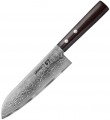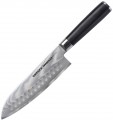Plastic type
The type of plastic used in a knife handle.
See "Handle Material" for general features of this material. The specific types of plastic found in modern kitchen knives are very diverse in price and quality. In low-cost models, the following options are mainly used:
— ABS plastic. One of the most inexpensive varieties of plastic; relatively fragile and brittle material that does not tolerate heat, temperature extremes and exposure to the sun. However, with proper quality and careful handling, such a handle can last quite a long time.
— Polycarbonate. More advanced than ABS, and at the same time quite affordable kind of plastic. It is thanks to this combination of affordability and practicality that polycarbonate is popular in the market.
— Polypropylene. Polypropylene is notable primarily for its light weight and high hardness, making it highly resistant to abrasion and scratches. This material is sensitive to sunlight and oxygen, but these shortcomings are often compensated by the use of special additives. Also, polypropylene can be supplemented with elastomer — a soft and elastic material that makes the handle more pleasant to the touch.
— Bakelite. One of the first plastics in history that still has not lost its relevance. One of the interesting features of bakelite is heat resistance: even on an open fire, such material is charred, but does not melt or burn.
In turn, premium knives can be used, in particular, the followin...g types of plastics:
— G10. One of the varieties of fibreglass is glass fibre with a plastic filler. G10 is characterized by excellent strength and durability, this material perfectly tolerates moisture and temperature changes, and it is quite difficult to scratch it. Fibreglass weighs much more than carbon fibre; on the other hand, its price is much lower.
— Carbon fibre (carbon fibre, Carbon Fibre, etc.). Composite material in the form of carbon fibre threads filled with plastic filler. This combination provides low weight and at the same time extremely high strength — even relatively simple grades of carbon fibre are not inferior to steel in this respect. However and these handles are not cheap. In addition, this material is sensitive to specific loads, namely point impacts — this may cause cracks on it. However, for such a "trouble", most likely, a very unfortunate set of circumstances will be required.
— Mikarta. Composite material, a kind of textolite, consisting of layers of fibrous material filled with polymer. The composition of the base and the filler may be different, sometimes it is displayed directly in the title — for example, Canvas Micarta uses fabric as the base (canvas — canvas). At the same time, regardless of the varieties, the manufacturing technology of such a handle involves high-pressure sintering. Due to this, a very strong, reliable and durable material is obtained, insensitive to moisture, high temperatures and sunlight, pleasant in appearance and to the touch. With all this, micarta is inexpensive, it is suitable even for low-cost kitchen knives.
— Packawood. Material based on laminated wood combined with synthetic resins. For such handles, different types of wood can be used, which allows you to get different patterns on the surface; and the possibility of using coloring additives further expands the variety of design of such knives. Externally, such handles are indistinguishable from wooden ones, but they are much harder, stronger and more resistant to moisture.
Air pockets
The presence
of air pockets in the design of the knife.
In its classical form, air pockets, or grantons, are small oval or oblong-shaped notches located along the blade. It is believed that they prevent the product from sticking to the blade, which is especially important when thinly sliced "sticky" foods like soft cheese. At the same time, the actual effectiveness of grantons can be different, it largely depends on the price category of the knife — the more expensive the product, the more carefully the manufacturer approaches the choice of the optimal shape of the recesses.
If we are talking about
cheese knives(see "Type"), then the air pockets are made in the form of continuous slots in the blade. At the same time, such slots can be quite large, so that the tool looks more like a “knife frame” than a full-fledged knife (although this impression is misleading).

